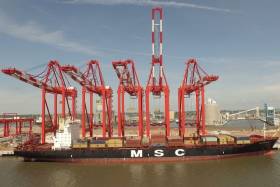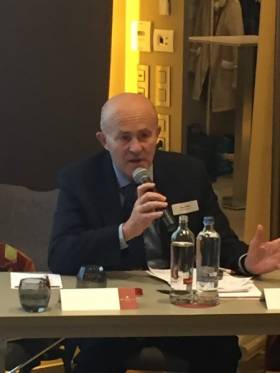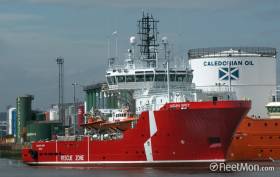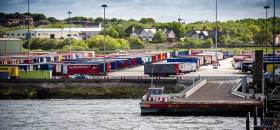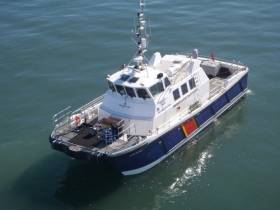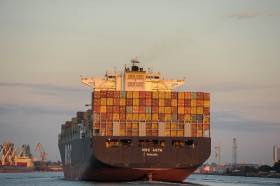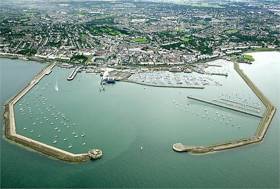Displaying items by tag: Ports & Shipping news
Shipping Review: IMO Agree Global Sulphur Cap, Brexit to Be Vicious, Liverpool2 Opens & New ESPO Chairman
#ShippingReview - Jehan Ashmore reviews the shipping scene from among the following stories over the last fortnight.
The International Maritime Organisation IMO reach agreement to maintain deadline of 2020 for introducing global cap of 0.5% sulphur content in marine fuels.
At the All-Island Civic Dialogue on Brexit, Taoiseach Enda Kenny has forecast “vicious” negotiations over Brexit. The forum follows the issue of Irish ports where the UK proposed to transfer frontline immigration controls to avoid enforcing a ‘hard border’ between the North and the Republic.
Liverpool2, a £400 million deep-water container port officially opened as an ocean gateway for the UK and connecting services to Ireland. The Port of Liverpool terminal is capable of handling ‘mega’ containerships, and has a catchment of over 35 million people, almost 58% of the UK’s population.
The European Sea Ports Organisation (ESPO) has elected Eamon O’Reilly as Chairman for the next four years. Earlier this year ESPO held their annual conference for the first time in Dublin which was hosted by the port company in which O’Reilly has been serving as Chief Executive since 2010.
European Sea Ports Organisation Elect Eamonn O’Reilly As New Chairman
#NewEPSOchairman - At the European Sea Ports Organisation (ESPO) General Assembly held in Brussels Eamon O’Reilly was unanimously elected as Chairman following a vote held yesteray. O'Reilly succeeds Santiago Garcia-Mila who chaired the organisation during the last four years.
The General Assembly also elected Annaleena Mäkilä and Bernard Mazuel as Vice-Chairs. Ms Mäkilä, who is currently Executive Director of the Finnish ports Association now starts a second term in that role. Mr Mazuel is Managing Director of the French Ports Association.
Upon his election, Mr O’ Reilly said: “I am very honoured to have been elected as Chairman of ESPO for the next two years. Over these years, ports will be challenged by the implementation of the Port Regulation and other legislative initiatives. There will also be a continuing need for ports to plan and finance major infrastructure investment at the key nodes of Europe’s transport networks. Overarching these challenges, however, is the global problem of climate change and how our industry plays its part in addressing this enormous issue.
“I would like to thank the Members of ESPO for putting their trust in me and I look forward to working with Isabelle and her excellent team as we represent the interests of Europe’s ports in our response to these challenges in the years ahead.”
Mr. O’Reilly has been serving as Chief Executive of the Dublin Port Company since 2010.
Today, ESPO has also published its Annual Report 2015-2016, which outlines the activities of the organisation over the past year. A copy of the report can be found here.
In addition, tonight will see the celebration of the 8th annual ESPO Award on Societal integration. The theme of this year is nature in ports. European Transport Commissioner Violeta Bulc will be announcing the winner at a ceremony taking place at the Palais d’Egmont in Brussels.
Shipping Snapshot: Cork Harbour's Diverse Range of Vessels
#PortSnapshot - Shipping movements in the Port of Cork have included in recent days a diverse range of vessels that are based and have visited the natural harbour, writes Jehan Ashmore.
Outlined below are vessels that Afloat.ie have tracked and their respective business activity.
Kinsale GasField Supply Support Ship: Ocean Spey a supply tug support vessel, newly introduced at the Kinsale Energy Ltd facility (formerly Marathon Oil) is currently operating offshore. The 66m vessel is reported to be registered in Ireland and is serving the pair of gas rig platforms located approximately 50kms off the south coast of Cork. Afloat will have more to report on Ocean Spey.
The vessel which also has anchor handling capabilities was built in 2000 and has a 1,864 gross tonnage. Meanwhile the main Kinsale Gasfield standby support ship, Pearl, operated by Cork based Mainport Group, (owners subsidiary Seahorse), is currently at the lay-by berth at Cork Dockyard, Rushbrooke near Cobh.
Brittany Ferries Flagship Service: Pont-Aven, Brittany Ferries flagship of 41,700 gross tonnage made her final Cork-Roscoff end of season sailing on Saturday.
In advance of the season the cruiseferry was fitted with 'scrubbers' to reduce harmful sulphur emissions (the only ferry in Irish waters with this 'green' technology as previously explained here).
The Ireland-France route began in 1978, the same year gas was first produced from the Kinsale Head area in the Celtic Sea. The 2,400 passenger/650 car ferry is to resume service in April, 2017.
Dutch Naval Submarine: A more unusual sight to Cork Harbour has been submarine HNLMS Bruinvis of the Royal Netherlands Navy (NATO member). The non-nuclear powered 68m submarine built during the Cold War is equipped with almost 40 torpedoes missiles.
The crew having paid a visit to Cork City for a long weekend departed yesterday using its diesel electric engines.
Official Opening of £400m Liverpool2 Container Terminal
#Liverpool2Opens - Liverpool2, one of the world’s most modern shipping terminals, officially opened last Friday at the Port of Liverpool by the Secretary of State for International Trade, Rt Hon Dr Liam Fox MP.
The £400 million investment by Peel Ports, one of the UK’s biggest port operators, will provide a state-of-the-art ocean gateway for UK importers and exporters with road, rail and canal connections linking directly to the heart of the UK mainland, accessing a catchment of over 35 million people, almost 58% of the UK’s population.
The new deep water facility will complement the existing Royal Seaforth Container Terminal at the existing Port of Liverpool, with each terminal having capacity to handle around 1 million containers per annum. The Port is already the country’s biggest transatlantic port (45% market share) and the only major container port in the north or west of the UK.
Liverpool2, which is one of the UK’s largest private sector infrastructure projects, was developed in response to changing trading patterns and shipping industry trends towards the use of ‘mega’ ocean-going container ships. Liverpool2 will now be able to handle the biggest cargo vessels in the world.
Mark Whitworth, CEO of Peel Ports said: “Today marks the beginning of a new era for the Port of Liverpool. Our investment will help global shippers to transport cargo more efficiently to their end destination with lower costs, congestion and carbon emissions. Liverpool is in the right location, providing state-of-the art facilities and technology, and offers a real competitive advantage with a shorter supply chain and providing an all-water route right to the heart of the UK via the Manchester Ship Canal.
“Liverpool 2 will create a new trading gateway in the UK. We are already exploring and succeeding in creating new opportunities for UK exporters, having recently signed a significant Memorandum of Understanding (MOU) to create a strategic alliance aimed at facilitating international trade and generating new business by promoting trade routes between Liverpool and the west coast of South America via the Panama Canal.”
Secretary of State for International Trade Liam Fox said: “Exporting is vital to the economic health of our nation. This investment at Liverpool2 will boost crucial cargo capacity, create local jobs and is yet another sign that the UK is open for business with the world.
“Liverpool is ideally located to increase our trade with countries west of the UK, including the US, Canada and South America, and this new port opens up even more opportunities with new markets and export destinations for UK businesses.”
Liverpool currently has around 8% of the container market in the UK. This figure would be expected to rise to between 15% and 20%.
Gary Hodgson, Chief Operating Officer of Peel Ports, added: “Being able to compete on the scale offered by Liverpool2 is only one aspect of how we’re transforming the port. Our real driving force is a commitment to customers, whether shipping lines or cargo owners, and helping them to achieve their business vision.
“As well as investing in the infrastructure and technology, we’re providing a more integrated service to our customers, whether that’s at the quayside, through port-centric logistics facilities or our wider network of ports.”
The occasion was marked with a major event for nearly 300 customers and stakeholders, featuring pyrotechnics during the opening ceremony and a performance by Alison Moyet.
The new expanded port facility will create an estimated 5,000 jobs direct and indirect jobs, stimulate further growth in the North-west and help to rebalance the UK economy.
Key facts and figures
The terminal construction has seen a site of around 16 hectares reclaimed from the sea. There is a new 854m quay wall and land created from 5.5 million tonnes of sand and silt dredged from the Mersey. The site is large enough to accommodate the stadiums of all four major Liverpool and Manchester football clubs.
The site currently has five ‘megamax’ ship to shore (STS) transfer cranes and 12 quayside container handling cranes (known as CRMGs). Ultimately there will be another three STS cranes and 10 CRMGs. These alone have cost £100m.
The apex of the STS cranes is 92m – four metres short of the height of Westminster’s Elizabeth Tower (Big Ben clock tower). When the boom is raised, it is more than 130m high.
35 million people in the UK & Ireland live closer to Liverpool than the traditional container ports in the South of England.
58% of the UK’s population is closer to Liverpool than its competitor ports in the south.
112km radius around Liverpool has the largest volume and density of large warehousing of any UK region.
More than 28% of the UK’s large warehousing is located in that area.
The North-west has seen a number of significant investments in supply chain warehousing, including warehouses to serve Waitrose, Aldi, Poundland, B&M, Matalan, Missguided and many others.
Brexit Negotiations Says Kenny At Forum Likely to be Vicious
#Soft/HardPorts - The Irish Times writes delegates at the All-Island Civic Dialogue on Brexit held in Dublin yesterday, heard that the UK are unaware of the hurt and anger towards it across EU.
Taoiseach Enda Kenny has forecast “vicious” negotiations over Brexit, reflecting a belief in Government circles that the British have underestimated the level of antagonism towards them across the European Union.
Top-level sources in Government believe there is little appreciation on the part of the UK government of the level of hostility they are likely to face once prime minister Theresa May triggers article 50 of the Lisbon Treaty.
New trading arrangements between the UK and the EU will have to be agreed by the remaining 27 member states and there are signs that at least some of those countries are determined to drive a hard bargain.
As previously reported on Afloat.ie, the issue of Irish ports and airports is where the UK proposed to transfer frontline immigration controls in measures to avoid enforcing a ‘hard border’ between the North and the Republic.
Speaking earlier this month, Northern Ireland Secretary, James Brokenshire, said that London and Dublin will work to strengthen Ireland’s external borders to prevent illegal migration to the UK.
The move would come into effect once the UK leaves the European Union.
Plans By Dublin Port to ‘Reorder Area’ So to Open Up to City
#PortReOrder – Frank McDonald of the Irish Times writes about plans by Dublin Port to ‘soften the hard edge’ between its Port Centre and the still-developing north Docklands.
Dublin Port, for long a nearly enclosed semi-industrial estate at the eastern end of Docklands, is planning to open up to the city with an imaginative scheme to reorder the entire area around its own headquarters off East Wall Road.
Project manager Jim Kelleher, who was responsible for the outstanding Diving Bell restoration on Sir John Rogerson’s Quay, says the aim is to “soften the hard edge” between Port Centre and the still-developing north Docklands area.
Port Centre, designed by Scott Tallon Walker and completed in 1981, has been marooned behind a stone wall that extends all along the east side of the heavily trafficked East Wall Road, which is extremely hostile to pedestrians.
Standing six storeys high on a podium, the new building replaced the port’s old headquarters at the Ballast Office, on the corner of Aston Quay and Westmoreland Street, which in turn was demolished and replaced by a half-hearted “replica”.
An architectural competition in 2014 led to Darmody Architects winning the commission to create a significant public space around Port Centre, including removal of parts of the unlisted stone boundary wall dating from the 1880s.
Principal architect Tim Darmody says his scheme is “all about port-city integration”, with an impressive set of gates on East Wall Road leading to a plaza in front of the port company’s headquarters and a landscaped “garden” to the south of it.
A new boundary made from pre-rusted Corten steel panels will replace the late 19th-century stone wall at southern end of the two-acre site, with a relocated 10-tonne Stothert & Pitt crane, dating from the 1950s, rearing up above the new wall.
This dramatic installation will be “painted, illuminated, celebrated”, as Jim Kelleher says, as a totem for Dublin Port and its history, clearly visible to motorists driving north across the East Link Bridge towards the Port Tunnel and M50 motorway. To read much more of a separate but port related development proposed by Dublin City Council, click here.
Afloat.ie adds among the reasons for the proposed crane relocation is the Alexandra Basin Redevelopment (ABR) project.
There has been a conservation assessment of such structures within the ABR that includes the site where Dublin Graving Docks Ltd operated until closure earlier this year.
In addition Afloat.ie is to further examine the background of the crane in greater detail as it forms part of the capital's port maritime industrial heritage.
Heysham Port's New Road Link Opens With Plans for Further Development
#PortLinks - Irish Sea and Isle of Man ro-ro operators using Heysham Port, in north-west England, now have a new link road, the Bay Gateway connecting the M6, bypassing congestion in Lancaster, writes Jehan Ashmore.
The Bay Gateway opened on Monday and the new road infrastructure will directly benefit the Lancashire port’s main cross Irish Sea clients, Seatruck Ferries and Stena Line. The Irish Sea's only dedicated unaccompanied freight trailer operator, Seatruck operates to ports in the Irish Republic and Northern Ireland. Stena's freight-only Heysham service concentrates solely to Belfast Port.
Also to benefit the Isle of Man Steam Packet Company whose main year-round route serves Douglas, where seasonal-routes fast-ferry, Manannan will for a second winter lay-up at the Manx capital until at least the end of this year.
In another development at Heysham (Peel Ports Group) has announced they are to invest in a new £10m link-span bridge and fourth berth. This is to accommodate larger ro-ro vessels.
The funding will also see a new pontoon built to support offshore crew transfer vessels, a new port entrance created and various improvements to the port IT and terminal operating systems. Work on the project to expand capacity begins this month and is scheduled to be completed in October 2017.
Port director, David Huck said: “This is a transformational time for Heysham port. Our major investment to increase capacity and flexibility will further strengthen the port’s role as a logistics hub for the region, particularly for services to Ireland and the Isle of Man. We’ve also built in an element of future-proofing, giving us the ability to accommodate projected volumes for many years to come.”
Heysham Port is also the closest to several major offshore infrastructure projects, the proposed National Grid connection of Moorside nuclear power station in Cumbria and the Dong Energy Walney Extension wind-farm.
Wicklow Based Craft Completes Charter in North Sea
#Charter - Alpha Marine, formerly Island Shipping, based in Wicklow, has seen the return of one of its wind-farm support vessels following a survey charter in the North Sea, writes Jehan Ashmore.
The water-jet propelled Island Panther had been working in the Waddenzee, an intertidal zone of the Ems Estuary located between The Netherlands and Germany. Along this coast are the Frisian /Wadden Islands, an archipelago that lies off these countries and stretches as far as Denmark.
Island Panther which also is a crew transfer vessel, was deployed from the Dutch port of Ijmuiden to conduct the survey zone. The 17m craft operated in the ultra-shallow waters of the survey site.
IMO Reach Agreement to Keep 2020 for 0.5% Global Sulphur Cap
#GlobalSulphur - The International Maritime Organistions IMO’s Marine Environment Protection Committee (MEPC) has reached an agreement on global sulphur cap.
The IMO last week agreed in favour of maintaining the deadline of 2020 for introducing a global cap of 0.5% sulphur content in marine fuels.
Responding to the breakthrough, the European Sea Ports Organisation (ESPO) congratulated the IMO on its decision. By setting 2020 as deadline for this global 0.5% sulphur cap, the IMO timing is being aligned with the EU timing as foreseen in the current Sulphur Directive. This will mean equal rules for EU and its neighbouring countries.
European ports are also convinced of the environmental and public health benefits of this reduction target.
Commenting on th decision, ESPO’s Secretary General Isabelle Ryckbost said “It is clear that limiting the sulphur exhaust emissions can have an enormous impact on the local air quality. This decision thus means a big step forward for the maritime and port industry and the people around the ports. In fact, 90% of European ports are very close to urban areas. Moreover, by maintaining 2020, IMO shows that an ambitious greening agenda is possible at global level. We must hope that IMO will demonstrate the same level of ambition when addressing climate change”
Shipping Review: Exports to UK Fall €300m, Dun Laoghaire Transfer ‘Imminent’ & IMDO Appointments
#ShippingReview - Jehan Ashmore reviews the shipping scene from among the following stories over the last fortnight.
Irish exports to the UK were €9.5bn in the first eight months of 2016, a fall of €300m for same period last year according to the Central Statistics Office (CSO).
Operators of a chemical and products tankers, Ardmore Shipping select the UK P&I Club as its second P&I club.
In the Seanad, Minister for Transport Shane Ross has said the transfer of Dún Laoghaire Harbour Company to the local council is ‘imminent’.
The Irish Maritime Development Office (IMDO) has made two new appointments to the organisations key management team.



























